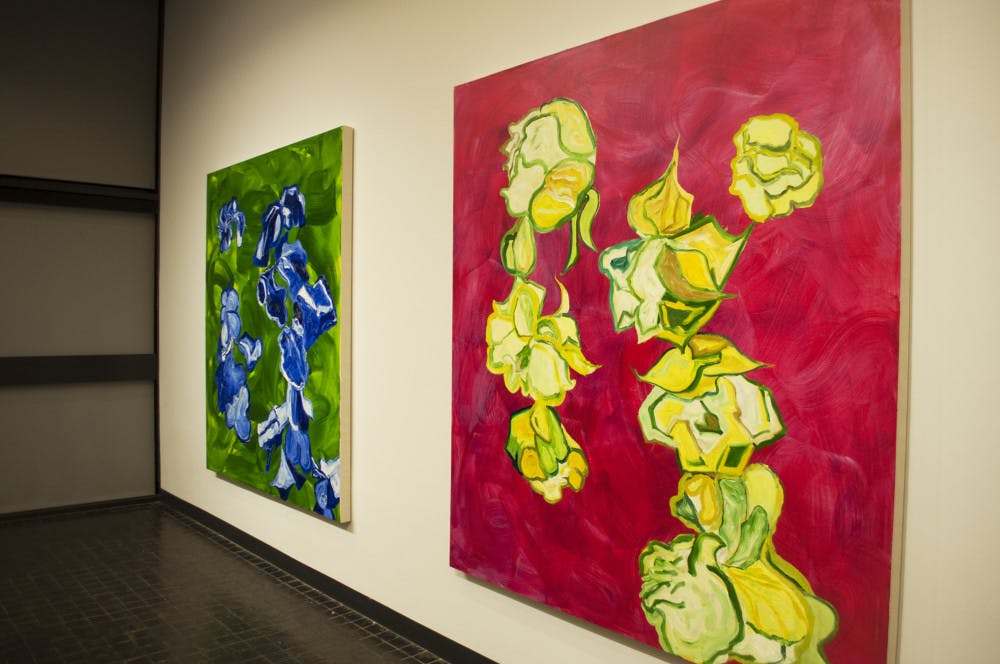Interactive projections, movable paintings and a musical statue, alongside more traditional paintings and sculptures, have transformed the David Winton Bell Gallery for the 2015 Faculty Exhibition. The display, which features artists across various disciplines and highlights interaction among different forms of media, opened Nov. 7.
“The exhibition really is a reflection of the interdisciplinary spirit that integrates the arts across the University,” wrote Ian Russell, one of the exhibition’s curators, in an email to The Herald. He noted that many of the works “connect around an interest in participation and interactivity that is uniquely shared amongst a number of faculty members at Brown.”
Not all of the faculty members featured in the exhibition are from the Department of Visual Arts. Todd Winkler, professor of music, created an interactive projection of the Providence sunset called “1,000 Sunsets.”
After moving to an apartment surrounded by windows a couple of years ago, Winkler said he became “obsessed with the sky over Providence, especially before and after sunset.”
“It’s so beautiful,” he said.
In the past, Winkler has combined video and theater pieces that incorporate multiple artists in an interactive way. This time, he said he wanted to create something simpler that he could do alone. For the Faculty Exhibition, Winkler presented an unfinished time lapse video, which he created by fixing a camera onto his deck and taking photos of the sunset outside his apartment every night for a few months.
“I’m interested in multi-sensual artwork that’s participatory in some way,” Winkler said. “I came up with the idea to index time with your body.”
By moving toward Winkler’s piece, “multiple layers of video crossfade from the most recent sunsets to the oldest, moving the images backwards in time,” the installation’s caption reads.
Moving from visual to aural forms of art, John Cayley, professor of literary arts, built a sound booth in which visitors interact with one of Amazon’s computer intelligence products, Alexa — the piece is called “The Listeners.” Walking into the booth, participants answer a series of questions from Alexa, which inquire about the participant’s emotional state. Depending on the participant’s answer, different responses ensue, creating an interactive performance between participant and machine.
Alexa is the first accessible robot that can be brought into domestic and public spaces, Cayley said. Unlike Siri, Alexa does not respond to only one user. Cayley said he was intrigued by this and therefore wanted to create a piece using Alexa. He noted that the piece is not “fantastically literary,” but he gave Alexa a certain voice. “I work in digital language arts. My background is as a poet, and I use computation and algorithm to try to make things that are poetic,” he said.
Ellie Irons, adjunct lecturer in art, created watercolor palettes using plants from her native Brooklyn and Colorado, where she was a resident artist at the Rocky Mountain Biological Laboratory. The piece in the exhibition, “Hue Dichotomies: A Meadow Spectrum,” compares the two palettes in a video that flashes onto a screen in the gallery.
In the interdisciplinary spirit of the exhibition, Irons’ work combines natural life and traditional painting. “In a gallery setting, my process has a lot to do with fieldwork and public interaction,” she said. “The installation is didactic in nature and tries to get information across, so it looks like something from a natural history museum.”
The goal of her work is to showcase the connections between humans and ecosystems and create greater empathy for non-human life, Irons said. “I hope that, by connecting the weeds and the plants and the other organisms to the urban dweller, that cultivates empathy for a range of types of ecosystems,” she said. “There’s more room for interpretation than in the average science display, though.”
Other notable works include an interactive musical instrument by Joseph Butch Rovan, professor and chair of the music department, and Jerry Mischak, senior painting critic at the Rhode Island School of Design. Made of wood, plastic, foam, vinyl tape and electrical circuiting, the brightly-colored and strangely-shaped object lets viewers elicit sounds by placing their fingers on its touch sensors.
A Nov. 9 multimedia performance by faculty in the music department accompanied the exhibit, and other special programs will take place in the future — including a series of panel discussions with the artists, Russell wrote.
“Our hope is that students and visitors will experience the exhibition as an open space where works from different disciplines and perspectives support each other in compelling and unexpected ways — how the fluidity of paint may support the texture of a video or the color of a watercolor may change how you perceive a sculpture,” Russell wrote, adding, “We feel this interdisciplinary dialogue is core to what makes the arts at Brown so unique.”





